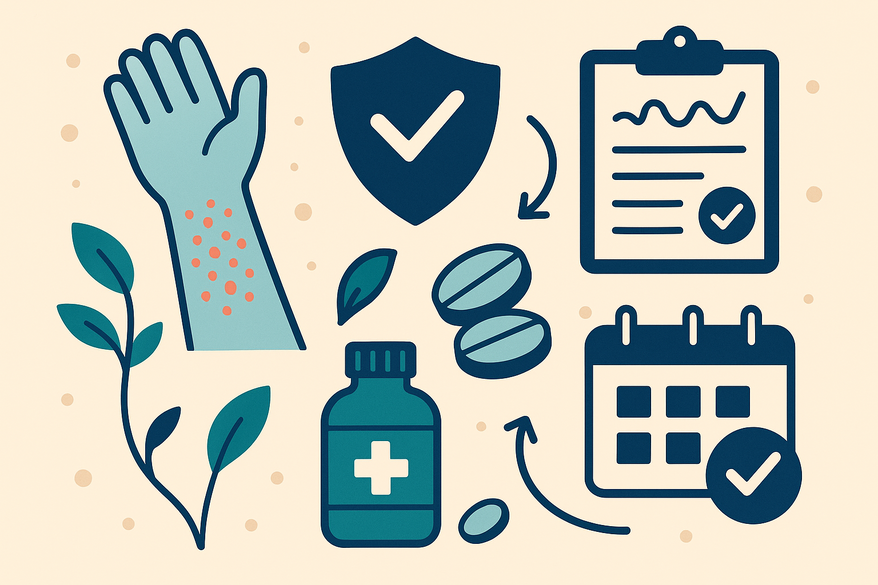Essential Long-Term Rash Management Strategies for Chronic Skin Conditions
Discover essential long-term rash management strategies to control symptoms, prevent flare-ups, and improve life quality for chronic skin conditions.

Estimated reading time: 8 minutes
Key Takeaways
- Proactive, multi-modal planning is essential for sustained relief of chronic rashes.
- Medical treatments such as antihistamines and corticosteroids form the backbone of therapy.
- Lifestyle modifications—diet, stress management, and environmental controls—help reduce flare-ups.
- Self-care routines like proper hydration, cooling measures, and soothing baths support barrier repair.
- Ongoing monitoring with diaries and photo logs ensures timely adjustments and optimal outcomes.
Table of Contents
- Understanding Chronic Rashes
- Overview of Long-Term Rash Management Strategies
- Medical Approaches and Prescription Treatments
- Lifestyle and Environmental Modifications
- Self-Care and Home Remedies
- Monitoring and Adjusting the Management Plan
- Final Thoughts and Recap
- FAQ
Understanding Chronic Rashes
“Understanding these conditions is essential, as chronic rashes… affect sleep, self-esteem, and overall quality of life.”
Chronic rashes persist for more than six weeks and often flare repeatedly, disrupting daily life.
- Eczema (Atopic dermatitis): Itchy, red, cracked patches that result from an inflammatory disorder.
- Psoriasis: An autoimmune condition causing rapid skin cell turnover and thick, scaly plaques. Learn more in our Eczema vs Psoriasis guide.
- Chronic Urticaria (Hives): Recurrent wheals and intense itching lasting over six weeks.
Common symptoms include:
- Intense itching and scratching
- Discomfort or pain from inflamed skin
- Sleep disruption
- Psychological stress and low self-esteem
Frequent triggers:
- Genetic predisposition
- Environmental allergens (pollen, dust mites, pet dander)
- Foods (dairy, nuts) and certain medications
- Stress and hormonal shifts
- Temperature extremes and harsh fabrics
Overview of Long-Term Rash Management Strategies
A sustained approach outperforms quick fixes by targeting underlying inflammation, repairing the skin barrier, and preventing recurrence.
The three pillars:
- Medical treatments tailored by a dermatologist or allergist.
- Lifestyle and environmental modifications to minimize triggers.
- Self-care and home remedies to soothe symptoms and support barrier repair.
Quick fixes like one-off steroid creams only mask symptoms. In contrast, ongoing monitoring and adjustments optimize outcomes over months.
Symptom Tracking
Maintain a detailed diary noting date, itch intensity (0–10), suspected triggers, treatments, and responses. Review entries weekly to identify patterns and guide your provider.
For enhanced tracking, use the step-by-step photo diary guide or try Rash Detector to upload photos, monitor changes, and generate AI-powered reports.

Medical Approaches and Prescription Treatments
Always collaborate with a healthcare professional to tailor doses and protocols.
- Second-Generation Antihistamines (cetirizine, loratadine) – Daily H1 blockers with minimal sedation.
- Intensification Protocols – Up-dosing second-generation agents or adding nighttime diphenhydramine; topical corticosteroids in short courses.
- Leukotriene Receptor Antagonists (montelukast) – Useful for some chronic urticaria cases.
- Advanced Systemics – Omalizumab for refractory hives; cyclosporine for severe eczema or urticaria.
Regular follow-ups ensure dose optimization, side effect monitoring, and timely escalation to biologics or immunosuppressants.
Lifestyle and Environmental Modifications
Dietary Changes
- Elimination diets under guidance to pinpoint food triggers.
- An anti-inflammatory diet rich in omega-3s, antioxidants, and leafy greens.
- Hydrate ≥2 L water daily to support barrier repair.
Stress Management Techniques
- Mindfulness meditation
- Gentle yoga (Child’s Pose, Cat-Cow)
- Cognitive Behavioral Therapy (CBT)
Daily Routine & Home Environment
- Cleanse with pH-neutral, fragrance-free products.
- Limit lukewarm showers to 5–10 minutes; pat skin dry.
- Wear loose, natural fabrics (100% cotton).
- Use HEPA filters and maintain 40–50% indoor humidity.
Self-Care and Home Remedies
Skin Hydration Protocols
- Emollients (petroleum jelly, shea butter)
- Humectants (glycerin, hyaluronic acid)
- Occlusives (beeswax, mineral oil)
- Routine: Apply thick moisturizer within 3 minutes of bathing, twice daily.
Cooling Measures
- Cold compresses (10–15 minutes)
- Cool shower rinses (20–25 °C for 5 minutes)
Topical Antipruritics & Soothing Baths
- Menthol 1% in aqueous cream for cooling relief.
- Colloidal oatmeal baths (1 cup, soak 10–15 minutes).
Building a Personalized Skincare Routine
- Fragrance-free, pH-balanced cleanse.
- Pat dry—never rub.
- Apply prescribed topicals.
- Seal moisture with a rich emollient.
Monitoring and Adjusting the Management Plan
- Visual checks: Redness, scaling, new lesions.
- Subjective scores: Itch intensity, sleep quality.
- Flare counts: Episodes per week/month.
Standardize weekly photos under consistent lighting and angles to compare progress. Adjust therapies if there’s no improvement in 2–4 weeks, new symptoms emerge, or side effects arise. Seek help for rapidly spreading rashes, systemic signs, or suspected infection.
Final Thoughts and Recap
- Combine medical treatments, lifestyle changes, and self-care routines.
- Focus on prevention, barrier repair, and symptom tracking.
- Review and adjust your plan regularly with a healthcare provider.
FAQ
- How long until I see improvement?
- Most patients notice symptom relief within 2–4 weeks of consistent regimen adherence, though full barrier repair may take several months.
- Can I stop medication once I feel better?
- Consult your provider before tapering. Many therapies require maintenance dosing to prevent relapse.
- Are home remedies enough?
- Self-care supports but usually complements prescription treatments for chronic conditions.
- How often should I update my photo diary?
- Weekly photos under the same conditions help you and your provider gauge progress objectively.





